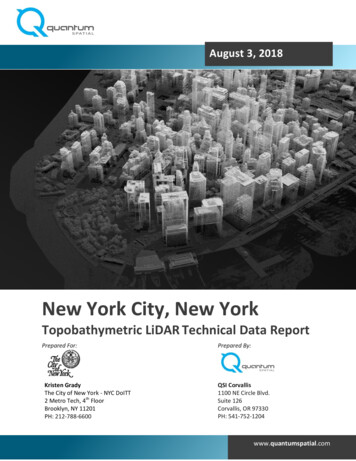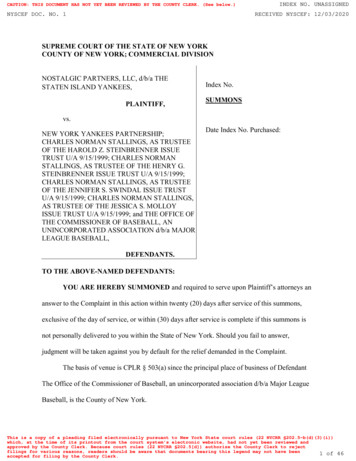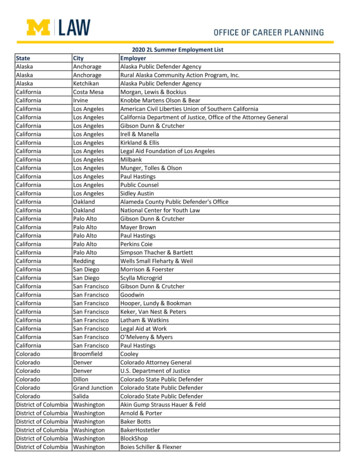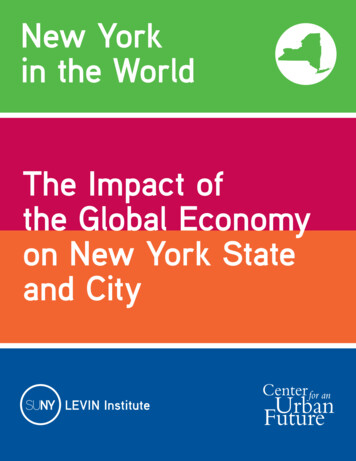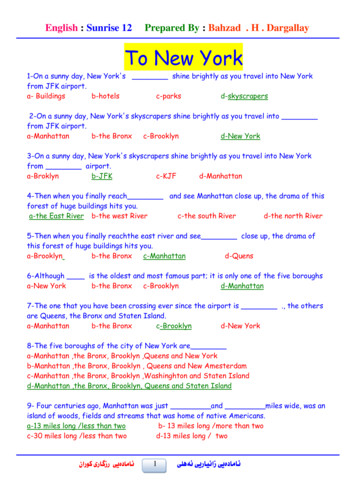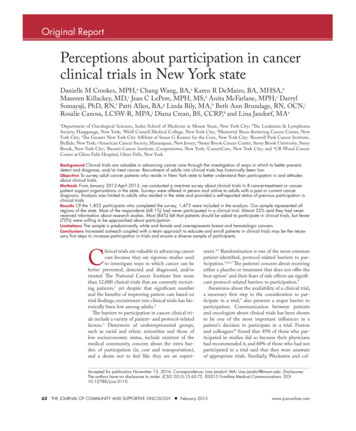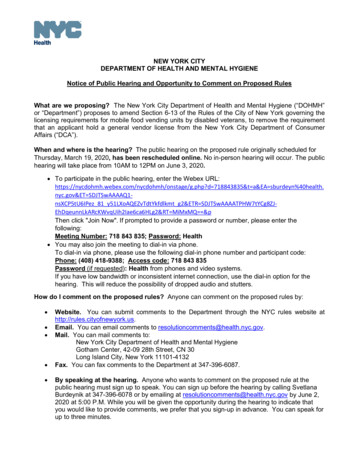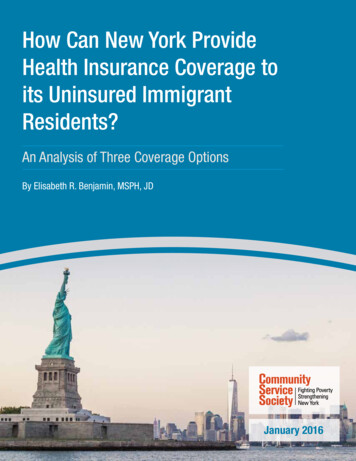
Transcription
How Can New York ProvideHealth Insurance Coverage toits Uninsured ImmigrantResidents?An Analysis of Three Coverage OptionsBy Elisabeth R. Benjamin, MSPH, JDJanuary2016January 2016
How Can New York Provide Health Insurance Coverage toits Uninsured Immigrant Residents?AN ANALYSIS OF THREE COVERAGE OPTIONSAcknowledgementsSolutions, and Bela Gorman at Gorman Actuarial.Agarwal, Steven Banks, Steven Newmark, RishiThis report was made possible through the gener-Special thanks are in order for our colleaguesSood, Samuel Solomon, Vicky Virgin, Marjorieous support and critical thinking of a dedicatedhere at CSS—David Jones, Steven Krause, AliaCadogan, and Lilliam Barrios-Paoli (who hasteam of funders, including: Rachael Pine of theWinters, Amanda Dunker, Carrie Tracy, and thesince left City government). We would also likeAltman Foundation; Irfan Hasan and Len McNally ofstaff of the Health Initiatives Department. Manyto acknowledge many of our colleagues who,The New York Community Trust; James Knickman,others contributed to our thinking about this work.unfortunately, are too numerous to list individually,David Sandman, Amy Shefrin, and Jessie Kava-In State government, we would like to thank: Paulbut work at the following organizations: Make thenagh of the New York State Health Foundation; andFrancis, Jason Helgerson, Troy Oechsner, DonnaRoad New York, the New York Immigration Coalition,Andrea Cohen, Chad Shearer, Deborah Halper, andFrescatore, Judy Arnold, Danielle Holahan, FrankChildren’s Defense Fund—New York, EmpireNathan Myers of the United Hospital Fund.Walsh and Courtney Burke (who has since leftJustice Center, and the Health Care For All NewState government). In New York City government,York Campaign.We are also grateful to our remarkable colleaguesMelinda Dutton and Laura Braslow at Manatt Healthwe would like to thank: Dr. Mary Bassett, NishaAll mistakes are, of course, the author’s.The Community Service Society of New YorkCSS’s Health Initiatives policy workAbout the Author(CSS) is an informed, independent, and unwaveringis generously supported by: the ACAElisabeth R. Benjamin, MSPH, JD, is Vicevoice for positive action that serves the needs ofImplementation Fund, the Altman Foundation,President of Health Initiatives at CSS where shelow-income New Yorkers. CSS addresses the rootthe Atlantic Philanthropies, the Ira W. DeCampoversees the Society’s health policy, advocacy, andcauses of economic disparity through research,Fund, the New York State Health Foundation,health consumer assistance programs. Previouslyadvocacy, and innovative program models thatThe New York Community Trust, the Robertshe worked at the New York Civil Liberties Union,strengthen and benefit all New Yorkers.Wood Johnson Foundation, and the UnitedThe Legal Aid Society, and Bronx Legal Services.www.cssny.orgHospital Fund.She attended Columbia Law School, HarvardSchool of Public Health, and Brown University.Support for this work was provided by thefoundations whose logos appear at right.The views presented here are those of theauthors and not necessarily those of theAltman Foundation, the New York State HealthFoundation, The New York Community Trust,or the United Hospital Fund.Cover photo: John Gillespie
An Analysis of Three Coverage OptionsExecutive SummaryThe Patient Protection and Affordable Care Act (“ACA”)has helped millions of New Yorkers to secure affordable,quality health coverage, many for the first time. However,many unauthorized immigrant New Yorkers are leftwithout coverage; ineligible for Medicaid, the new EssentialPlan, or Qualified Health Plans in the New York State ofHealth Marketplace. Lack of coverage is burdensome forimmigrants and our greater society alike. For immigrantfamilies, lack of coverage can mean excess mortalityand morbidity, as well as financial ruin. Everyone elsecontributes to the hidden health costs for the uninsuredthrough government-financed payment mechanisms such asuncompensated care funding and public and private payercost shifting.In New York, despite the State’s expansive public insuranceprograms, as many as 457,000 unauthorized, uninsuredimmigrants remain ineligible for coverage. This paperexplores options for New York State to fill the void leftby the ACA and provide health coverage to the mostvulnerable—either because of their income or age—ofthese immigrants who are “uninsurable” because of theirineligibility for most federal coverage programs. We offerNew York policymakers practical, affordable, high-qualitycoverage options that would solidify our State’s leadershipposition in welcoming new Americans.The three coverage options investigated here are: (1) acomprehensive “Essential Plan” for undocumented adultswith incomes below 200 percent of the Federal PovertyLevel (“FPL”); (2) a Young Adult plan for undocumentedimmigrants between the ages of 19 and 29 that builds uponNew York State’s popular Child Health Plus program;and (3) a high deductible “Bronze Plan” with first dollarpreventive care and emergency services for undocumentedadults who are eligible for Emergency Medicaid. For eachoption, the paper describes the kind of benefits offered,who would be covered, and how much it would cost.These State coverage options would extend healthinsurance to between 90,100 and 241,600 immigrant NewYorkers, at a cost ranging from 78 million to 462 millionannually. The first option, which opens the State’s EssentialPlan to all low-income New Yorkers, would cost the most, 462 million, but it would also cover the most people,roughly 111,100 New Yorkers. The second option, offeringcoverage to 27,900 young adults, could potentially actas an interim measure, and is the most affordable at 78million. The final option, purchasing a Bronze Plan for verylow income immigrants, would cost the State 307 million,and would provide free preventive and emergency care to85,000 New Yorkers. Even the most ambitious of theseproposals would result in a less than 1 percent increase inour State’s health budget of roughly 60 billion.1New York State has a long and illustrious history as agateway for new Americans. This paper demonstrates thataffordable, high quality and viable options exist that bothimprove the lives of our newest State residents and closethe coverage gap left by the Affordable Care Act.Table 1: Summary of Coverage Options, Enrollment, and CostsProgram OptionNumber EligibleEstimated # ofEnrolleesTotal AnnualState CostsAnnual State Costper Enrollee241,600111,100 462,000,000 4,1572. Young Adult90,10027,900 78,000,000 2,8043. Bronze Plan203,60085,000 307,000,000 3,6061. Essential Plan 2016 by The Community Service Society of New York. All rights reserved.Community Service Society www.cssny.org3
Covering New York’s Uninsured Immigrant ResidentsIntroductionImmigrant Coverage: The unfinished business of health reformThe Affordable Care Act (“ACA”) has benefitted over 2million New Yorkers by enrolling them into comprehensive,affordable health coverage through the New York State ofHealth Marketplace.2 But while the ACA has significantlyimproved options for most New York State residents,nearly half a million uninsured unauthorized immigrantsface severely limited coverage options compared to theircitizen and lawful immigrant counterparts. This is truedespite their contributions to our State—the Institute onTaxation and Economic Policy estimates that in 2012,undocumented immigrants paid over 1 billion in state andlocal taxes in New York.3Historically, New York State has adopted several measuresto address the health needs of immigrant residents,making the State a national leader in immigrant access andcoverage. For example: In the 1980s, New York extended Medicaid coverageto undocumented pregnant women.4 In 1990, New York enacted its landmark Child HealthPlus program, which now provides coverage to allchildren who are ineligible for Medicaid—includingundocumented children—up to the age of 19.5 In 2001, in the Aliessa case, New York’s highest courtheld that nearly all low-income, non-qualified “aliens”are eligible for full Medicaid benefits, in spite of afederal law barring federal Medicaid funding for thispopulation.6 For the remaining low-income, undocumentedimmigrant population, New York offers the jointly(federal/State) financed Emergency Medicaid programand, in 2007, expanded the scope of its benefits tocover the costs of treating end stage renal disease andcancer.7Through these programs, New York State has cobbledtogether coverage for selected groups of immigrants,4www.cssny.org Community Service Societyincluding: undocumented children at all income levels,pregnant women up to 200 percent of the Federal PovertyLevel (“FPL”), and people who experience medicalemergencies with incomes below 138 percent of the FPL.New York State is not entirely alone—as many as 18 otherstates offer some form of coverage to their non-citizenresidents above and beyond the jointly federally/statefunded Emergency Medicaid program—but New York hasdone more to provide coverage to immigrants than almostany other state.8Continuing New York’s laudable history of providingcoverage to immigrants, the New York State of HealthMarketplace is designed to be as welcoming as possible toeligible undocumented immigrant families and individuals,enrolling them into Child Health Plus and pre-qualifyingthem for Emergency Medicaid.New York City, too, is attempting to address the healthneeds of its undocumented residents. In October 2015, theMayor’s Task Force on Immigrant Access issued a reportthat calls upon the State to explore strategies to providecoverage to the State’s undocumented immigrants andproposes that the City launch a “direct access” program forNew York City’s undocumented immigrants in the interim.9With an initial 6 million in funding, the program is slatedto begin in 2016 and will serve 1,000 immigrants.As critical as these efforts have been, however, the currentcoverage system leaves most undocumented adults withoutcomprehensive coverage options.This fissure in New York’s coverage landscape isproblematic both for immigrant families and for societyat large. At the individual level, numerous studies indicatethat people without coverage are more likely than theirinsured counterparts to delay seeking preventive care andservices for serious and chronic health conditions.10 Surveysindicate that people without coverage report that theyavoid accessing medical care for fear of costs associatedwith receiving treatment.11 When they do seek treatment, itis of lower quality,12 and they are at higher risk of incurringmedical debt and/or bankruptcy.13 Recent research nowshows that access to coverage is associated with significant
An Analysis of Three Coverage Optionsreductions in mortality14 and improvements in mentalhealth,15 at least in part due to higher continuity of care.16Lack of coverage for a significant portion of New York’spopulation also causes problems for the broader healthcare system because it causes payers and providers tocharge more to the insured population in order to offset thelosses in providing care to the uninsured.17 Unauthorizedimmigrants use health care less than U.S. citizens. However,when they do utilize care, unauthorized immigrants relyon the publically-financed uncompensated care system,using it two times more than their legal immigrant andcitizen counterparts.18 Exacerbating this situation is theACA’s gradual reduction in federal Disproportionate ShareHospital (“DSH”) funding, which traditionally has offsetthe cost of hospital care for the uninsured and is slated tobegin ratcheting down in 2017.19 New York State receivesmore of this funding than any other state20 and is likely tobe the state hardest hit by these cuts.21How many immigrant New Yorkers are without coveragebecause of their immigration status?New York has the fourth largest “unauthorized” immigrantpopulation in the country, after California, Texas, andFlorida. According to the Migration Policy Institute (“MPI”),there are 867,000 unauthorized immigrants amongst NewYork’s 19 million residents (of whom 74 percent or 643,000live in New York City).22 Ninety percent (786,000) of NewYork’s unauthorized population are adults age 19 and over,and 25 percent (217,000) are young adults, age 19–29.23MPI further estimates that 53 percent, or 457,000, ofundocumented immigrants in New York are uninsured.24However, not all “unauthorized” immigrants are ineligiblefor coverage. The term “unauthorized immigrants”includes both the undocumented and many categories oflawful immigrants who are eligible for coverage underNew York State-funded Medicaid or federally-subsidizedMarketplace coverage through Qualified Health Plans orthe Essential Plan. For example, the term “unauthorized”immigrants includes some New York immigrants who areImportant Immigration TermsUndocumented Immigrants: Undocumented immigrantsrefer to people who entered the United States withoutinspection by Customs and Border Protection or who stayedbeyond their period of authorized stay. In New York, someundocumented immigrants are eligible for: Medicaid (for lowincome pregnant women only); Child Health Plus (for childrenunder the age of 19); Emergency Medicaid (for low-incomepeople who are experiencing medical emergencies).PRUCOL (Permanently Residing Under Color of Law):People who are PRUCOL can show that USCIS or ICE (themain federal immigration agencies) have given permission orknow (and therefore acquiesce to their presence) that theyare seeking to live permanently in the United States. ManyPRUCOL people are considered “lawfully present,” but someare not (and hence, are ineligible for ACA benefits). They arenot considered undocumented for the purposes of gettinghealth insurance. In New York, all low-income adult PRUCOLsare “immigrant”-eligible for Medicaid or the Essential Plan.But a small number of adult “residual PRUCOLs,” withincomes above the Medicaid levels, are ineligible for theEssential Plan and Marketplace coverage because of theirimmigrant status (e.g. Deferred Action for Childhood Arrivals,applicants for deferred action).Unauthorized Immigrants: This is a general term usedby researchers. It refers to people who are undocumented,but includes many people who are PRUCOL. Their eligibilityfor coverage is determined by whether the unauthorizedimmigrant is PRUCOL or undocumented.permanently residing under color of law (“PRUCOL”).While the lowest-income PRUCOL adults are eligible forMedicaid or Essential Plan coverage, some of the higherincome PRUCOL adults do not have access to Marketplacecoverage (neither Essential Plan nor Qualified HealthPlans). Five of the over a dozen categories of PRUCOLadults are referred to as the “residual PRUCOLs,”described in Box One, and can access Medicaid (if lowincome), but cannot access Essential Plan or Marketplacecoverage (if moderate or high-income).25 By contrast, allCommunity Service Society www.cssny.org5
Covering New York’s Uninsured Immigrant Residentsunauthorized children currently have access to Medicaidor Child Health Plus (if a “residual PRUCOL” orundocumented), with cost sharing at higher income levels.Unfortunately, there are no comprehensive estimatesbreaking down the unauthorized population into those whoare and are not eligible for a subsidized coverage option.Drawing upon available published information and expertestimates, the CSS team constructed an estimate of thepopulation in New York State who are currently ineligiblefor subsidized coverage due to immigration status. Forexample, the CSS team used data indicating that there are53,000 PRUCOL immigrants currently enrolled in NewYork State-funded Medicaid because of litigation broughton behalf of PRUCOL and other immigrants.26 Similarly,CSS used data compiled by experts at the Kaiser FamilyFoundation that estimated 12 percent of the 2.2 millionuninsured in 2014, or 264,000 people in New York State,are ineligible for Medicaid or Marketplace coverage due totheir immigration status.27 CSS also integrated available dataabout the numbers of undocumented immigrants into ourestimates. Since 2014, low-income undocumented adultshave been able to pre-qualify for Emergency Medicaidthrough the Marketplace. To date, 68,000 have done so.28Table 2 displays the estimated number of immigrantsin New York State by their age and immigration status,to help distinguish immigrants who currently do nothave access to coverage from the broader unauthorizedimmigrant estimates available from MPI and others.Table 2 indicates that the 867,000 unauthorized immigrantpopulation in New York State consists of approximately:330,000 undocumented adults; 456,100 PRUCOL adultimmigrants; and 80,900 unauthorized children below theage of 19 years. It also describes these groups by coveragestatus. Of the undocumented adult immigrants, 264,000are uninsured. Of this number, 68,000 undocumentedimmigrants have prequalified for Emergency Medicaid and196,000 have not. An additional 32,000 immigrants haveenrolled into Emergency Medicaid in the past and another34,000 are estimated to have other or private coverage (forexample, spousal coverage).29 The table further describesthe coverage distribution of the PRUCOL adults. Of the456,100 total estimated PRUCOL immigrants in NewYork State, an estimated 180,900 are uninsured; 53,000are enrolled into Medicaid; and 222,200 have other/privatecoverage. Appendix A provides further methodologicaldetail about these estimates.Table 2: Unauthorized NYS Population by Coverage and Immigration Status (Baseline)Unauthorized Adults (Age 19 )Undocumented AdultsTotal %457,00053%- Prequalified forER Medicaid68,00021%n/an/an/an/an/an/an/an/a- Not prequalifiedfor ER /CHP(incl. Historic 2,00015%267,50031%Uninsured TotalTotal6Total Unauth. Adults(Undoc. PRUCOL)PRUCOL AdultsUnauthorized Children(Age 0–18)330,000www.cssny.org Community Service Society456,100786,10080,900867,000
An Analysis of Three Coverage OptionsThese estimates represent the current categorization ofNew York’s unauthorized immigrants by status category.But, as described below, many immigrant adults couldchange from undocumented to PRUCOL status if a 2014Executive Order issued by President Obama were in effect.Executive Order. On November 9, 2015, the U.S. Courtof Appeals for the Fifth Circuit upheld the lower court’sdecision and the case is headed for the Supreme Court for afinal determination.At the time of publication of this report, the outcome of theDACA/DAPA Order is unclear. Accordingly, while the mainbody of this report assumes that DACA/DAPA will not beimplemented, Appendix B presents an alternative series ofeligibility, enrollment and cost estimates in the event thatthe President’s Executive Order is implemented.President Obama’s Executive OrderOn November 20, 2014, President Obama issued a farreaching Executive Order, called Deferred Action for theParents of Americans and Lawful Permanent Residents(“DAPA”) and expanding the existing Deferred Action forChildhood Arrivals (“DACA”) program (“DACA/DAPA”).The DACA/DAPA Order built upon a more modest federal2012 administrative measure, called Deferred Action forChildhood Arrivals, which granted immigration relief toundocumented immigrants who had arrived in the UnitedStates while they were children.30Coverage OptionsIf implemented, President Obama’s DACA/DAPA ExecutiveOrder would profoundly change the immigration statusof hundreds of thousands of New York’s undocumentedimmigrant population, by essentially rendering themnewly “PRUCOL.” Those who are low-income would beeligible for State-funded Medicaid (or the Essential Plan),as a result of 2001 Aliessa litigation, described above.But on February 17, 2015, a Texas District Court stayedthe implementation of President Obama’s DACA/DAPAThis report investigates three coverage options foraddressing the coverage needs of undocumented immigrantNew Yorkers: (1) a comprehensive Essential Plan Option(New York’s name for the ACA’s Basic Health Plan option)for 241,600 undocumented adults with incomes below 200percent of the FPL; (2) a Young Adult Option for 90,100undocumented immigrants between the ages of 19 and29 that builds on our State’s Child Health Plus program;and (3) a Bronze Plan Option for 203,600 undocumentedadults who could pre-certify for Emergency Medicaid.Table 3 presents a brief overview of the coverage options.Because the vast majority of New York’s unauthorizedimmigrants are low-income, many of these options seek toleverage Medicaid funding, whenever possible. MedicaidTable 3: Description of Coverage Options: Enrollee Eligibility, Benefits, and Premiums1. Essential Plan2. Young Adult3. Bronze PlanEligible PopulationFederal Poverty LevelActuarial Value/Cost SharingMonthly PremiumEnrollment Period241,600Undocumented andPRUCOL adults 200% of FPL.95–.99 0 150% of FPL 20 150% of FPLYear-round, continuousopen enrollment90,100Undocumented andPRUCOL adults age19–30 400% of FPL.70–.99 0- 175 pm/pmsliding fee scale3-month open enrollmentand/or special enrollmentperiods under the ACA203,600Undocumented adults 138% of FPL.60 value ofEmergency Medicaidbenefits 03-month open enrollmentand/or special enrollmentperiods under the ACACommunity Service Society www.cssny.org7
Covering New York’s Uninsured Immigrant Residentsis a public insurance program that is jointly funded by thefederal and New York State governments, typically on afifty-fifty basis.A description of each option, the numbers of immigrantswho are eligible, the number estimated to enroll, and the2016 State costs to offer coverage are described below.Option One: The Essential PlanBeginning January 1, 2016, New York State will becomethe second state in the nation to offer a Basic HealthPlan (renamed the “Essential Plan” in New York). Statepolicymakers opted to offer the Essential Plan for tworeasons: first, it significantly improves the affordability ofcoverage for low-wage New Yorkers; and second, it offersthe State substantial federal funding—at least 645 millionannually—for covering many of the Aliessa immigrantswho were previously enrolled in State-only fundedMedicaid.31The Essential Plan Option is the most generous of thethree options presented by this paper. For enrollees, thecoverage is both affordable in terms of no or very lowpremiums and cost-sharing while still offering extremelycomprehensive benefits. Unlike the other two options, it hasthe flexibility of continuous year-round open enrollment,meaning that consumers can join at any time, withoutwaiting for an annual open enrollment or qualifying for aspecial enrollment period. While the Essential Plan Optionis the most expensive of three options presented here, it iscost-efficient for the State because it builds off of publichealth—rather than commercial—insurance plan networks.As a separate public risk pool, it would have little or noimpact on the State’s individual commercial insurancemarket and risk pool.The Essential Plan Option: What are the benefits?The Essential Plan offers comprehensive health coverage ina health plan with no deductibles, very low cost-sharing,and no, or very low, premiums. For example, the premiumis free for individuals with incomes below 150 percent of8www.cssny.org Community Service Societythe FPL and 20– 40 a month for people between 150and 200 percent of the FPL, depending upon whether anindividual opts for vision and dental.32 The plan’s actuarialvalue, or the portion of health care paid for by the planversus an enrollee, is generous, pegged between 95 and 99percent, or equivalent to a comprehensive platinum planoffered on the New York State of Health Marketplace.33 In2016, 14 health plans in New York are participating in theEssential Health Plan program.The Essential Plan Option: Who would be eligible and who wouldjoin?Under this option, the Essential Plan would be available toan additional 241,600 adult immigrants who are age 19or over (and thus over age for New York’s Child HealthPlus program) and below 200 percent of the FPL. Most ofthese enrollees would be undocumented adults, but a smallnumber of “residual PRUCOL” adults who are currentlyineligible for the Essential Plan or other qualified healthplans on the Marketplace would also be enrolled. Thislatter group could be separately covered as described inBox One.As described in Table 4, the eligible population iscomprised of four groups:1. historic enrollees in the State’s Emergency Medicaidprogram opting into the Essential Plan;2. new enrollees with incomes below the Medicaid levelof 138 percent of the FPL (including uninsured peopleand those who have pre-qualified for EmergencyMedicaid);3. new enrollees with incomes between 138 and 150percent of the FPL who will be charged no premiums;and4. new enrollees with incomes between 150 and 200percent of the FPL who will be paying 20 per monthpremiums.Table 4 describes the number and percent of peopleexpected to enroll in, or “take-up,” an Essential Plan
An Analysis of Three Coverage OptionsOption. The take-up rates of the four groups of potentialenrollees depends on their past use of the health caresystem or the amount of premiums and cost sharing theyare expected to incur when they enroll in the Essential Plan.The first group is those who were historically enrolledinto the Emergency Medicaid program. They are mostlikely to enroll because they have health needs and havealready overcome barriers to entering a State insuranceprogram, such as fear of disclosing their immigrationstatus to a government entity. They could easily enrollwith the Essential Program when they utilize the system.We estimate that 85 percent of the “Historic EmergencyMedicaid Enrollees” are likely to enroll.The next two groups of Essential Plan enrollees wouldhave no premiums and slightly different State-specifiedbenefit packages and cost-sharing, which are set by incomelevels (those below 138 percent of FPL; and those between138 and 150 percent of FPL).34 These two groups do notnecessarily have high health needs. While some may havepre-qualified for Emergency Medicaid, others may be morereticent about joining a public program than the HistoricEmergency Medicaid program enrollees.35 Forty-onepercent of these newly-eligible populations are likely tojoin.36Table 4: Essential Health Plan OptionTotal Eligible and Take-up by Income GroupTotal EligibleTake-up32,30027,400 (85%)171,30069,700 (41%)New Enrollees 138% to 150% of FPL( 0 monthly premium)13,5005,500 (41%)New Enrollees 150% to 200% FPL( 20 per member/per month)24,5008,500 (35%)241,600111,100 (46%)Historic Emergency Medicaid Users 138% of FPL( 0 monthly premium)New Enrollees 138% of FPL( 0 monthly premium)Total EnrolledThe final group, newly-eligible enrollees between 150 and200 percent of poverty, will pay premiums, which may beexperienced as a barrier to entry (although not a very greatone) and so a smaller number (35 percent) are estimated toenroll. Collectively, these latter three groups are referredto as the “New Enrollees” as opposed to the “HistoricMedicaid Enrollees.”The Essential Plan Option: How much would it cost?Determining the costs of offering the Essential Plan toNew York’s undocumented immigrants requires a series ofassumptions, broken down here into five steps. First, westart with a baseline of cost data from the State’s FamilyHealth Plus (“FHP”) program. While the FHP programended in 2015, its claims data is illustrative because it:enrolled beneficiaries with a similar risk and incomeprofile, used similar provider networks, and offeredsimilar benefit packages as the Essential Plan. Second, weconduct a population analysis of the groups likely to join(discussed above). Third, we make morbidity and selectionadjustments for the projected enrollee population. Fourth,we apply other actuarial adjustments, such as incorporatingestimates for geographic distribution of the enrolleepopulation, medical trend, administrative costs, and theunique benefit packages offered to enrollees based on theirincome levels. And finally, we estimate the cost offsetsbetween the gross costs of the Essential Plan Option fromthe costs of the existing Emergency Medicaid program todetermine the net cost of the program to New York State.These steps are described in turn below.Population Cost Analysis. Determining the costs of offeringthe Essential Plan to undocumented New Yorkers requiresan analysis of the estimated medical and administrativecosts of offering the program to potential enrollees. Inthis case, because there are two very different populationsentering the program, CSS estimated first the costsassociated with enrolling the Historic Emergency Medicaidenrollees, who are relatively sick, and second, the costsassociated with the New Enrollees, who are relativelyhealthy.Community Service Society www.cssny.org9
Covering New York’s Uninsured Immigrant Residents Historic Emergency Medicaid Population. As shown inTable 5, CSS analyzed 2011 New York State Medicaidclaims data which indicates that 493 million in claimswere incurred for the 32,000 Emergency Medicaidenrollees.37 Of these, 87 percent of the claims were forhospital inpatient services and four percent were fordialysis. The cost on a per enrollee basis was nearly 15,000 a year, or 1,250 per month.38New Enrollee Population. There are 209,000 NewEnrollees who would be eligible for the Essential Plan.CSS assumes that the New Enrollee population is ashealthy, if not healthier, than the FHP population.39Morbidity and Selection Adjustments. The CSS team modeledmorbidity and selection adjustments using data from the2014 Federal Actuarial Value Model, as shown in Table 6.Morbidity is a term that describes the disease and conditionburden in the cohort population. Selection is a
Level ("FPL"); (2) a Young Adult plan for undocumented immigrants between the ages of 19 and 29 that builds upon New York State's popular Child Health Plus program; and (3) a high deductible "Bronze Plan" with first dollar preventive care and emergency services for undocumented adults who are eligible for Emergency Medicaid. For each



